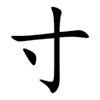寸
| ||||||||
Translingual
| Stroke order | |||
|---|---|---|---|
 | |||
Han character
寸 (radical 41, 寸+0, 3 strokes, cangjie input 木戈 (DI), four-corner 40300, composition ⿹𬺰丶)
- Kangxi radical #41, ⼨.
Descendants
References
- KangXi: page 293, character 32
- Dai Kanwa Jiten: character 7411
- Dae Jaweon: page 581, character 4
- Hanyu Da Zidian: volume 1, page 503, character 8
- Unihan data for U+5BF8
Chinese
| simp. and trad. |
寸 | |
|---|---|---|
Glyph origin
| Historical forms of the character 寸 | |||
|---|---|---|---|
| Western Zhou | Warring States | Shuowen Jiezi (compiled in Han) | Liushutong (compiled in Ming) |
| Bronze inscriptions | Qin slip script | Small seal script | Transcribed ancient scripts |
 |
 |
 |
 |
| Characters in the same phonetic series (寸) (Zhengzhang, 2003) | |
|---|---|
| Old Chinese | |
| 村 | *sʰuːn |
| 忖 | *sʰuːnʔ |
| 刌 | *sʰuːnʔ |
| 寸 | *sʰuːns |
Ideogram (指事) – a position on the forearm where the pulse can be palpated by compressing the radial artery. It is called 寸口 in modern Chinese and the meaning of a unit of measurement is derived from the distance between the wrist and this position. Compare 又, 手, 九, 爪.
Etymology 1
Pronunciation
Definitions
寸
- (units of measure) A cun or Chinese inch, a traditional unit of length of about 3 cm.
- (Mainland China) Short for 市寸.
- (Hong Kong) Legally defined as the tsun of 3.71475 cm.
- (informal) Short for 英寸 (yīngcùn, “inch”).
- (figuratively) very short or little
- (traditional Chinese medicine) cunkou pulse; radial artery pulse at the wrist
- (Mandarin, colloquial) coincidental; unbelievable; opportune
- A surname.
Compounds
Derived terms from 寸
|
Etymology 2
| For pronunciation and definitions of 寸 – see 忖 (“guess, suppose, conjecture”). (This character, 寸, is a variant form of 忖.) |
Japanese
Readings
Noun
Korean
Hanja
Pronunciation 1
寸 • (chon)
- This term needs a translation to English. Please help out and add a translation, then remove the text
{{rfdef}}.
Pronunciation 2
寸 • (chi) (hangeul 치, revised chi, McCune–Reischauer ch'i, Yale chi)
Vietnamese
This article is issued from
Wiktionary.
The text is licensed under Creative
Commons - Attribution - Sharealike.
Additional terms may apply for the media files.